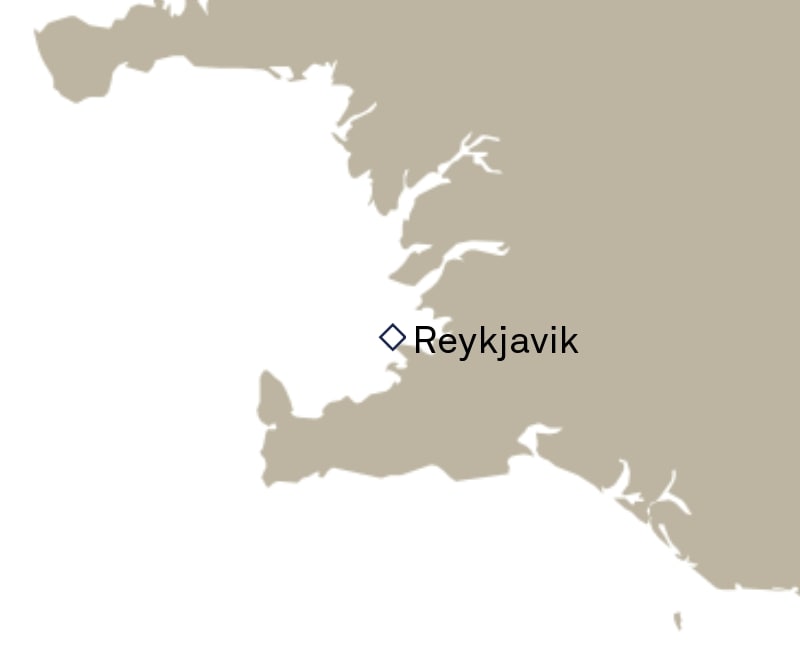Reykjavik, Iceland cruises

Reykjavik port guide
What was once a traditional fishing village now serves as the island's cultural centre, as travellers far and wide come to experience this unique city surrounded by extraordinary lagoons, geysers, waterfalls, and volcanoes.
Perched on the Seltjarnar Peninsula on the southern shore of Faxa Bay, the southwestern city of Reykjavik offers guests a memorable stay in the North Atlantic.
Here’s our guide on everything you need to know about exploring Reykjavik.
Top landmarks and sights in Reykjavik
Reykjavik offers a wonderful range of things to see, giving you a generous glimpse into the history and culture of this part of the world, from the 19th-century Parliament House to the pretty streets of old Reykjavik.
The Sun Voyager
The Sun Voyager, a sculpture by Jon Gunnar Arnason, is described as an ode to the sun. Representing the promise of undiscovered territory, a dream of hope, progress, and freedom, this steel boat sculpture by the sea makes for a photogenic sight.
The Parliament House, Alþingi
The parliament building and a historic cathedral overlook the leafy green square of Austurvollur, a public garden home to a statue of Jon Sigurdsson, the leader of Iceland’s independence movement. During the Christmas season, here you can enjoy festive displays and the view of a Christmas tree gifted annually from Oslo.
Old Reykjavik
Venture into old Reykjavik to wander along the colourful display of corrugated iron houses along narrow streets. Diverse architecture and quirky street art paint this creative city making it one of the most charming sights to enjoy in Reykjavik.
Grotta Lighthouse
To watch the magical Northern Lights dance across the dark night, head to Grotta Lighthouse, located on the northwest tip of Reykjavik. With clear skies and the right conditions, you can bear witness to one of Mother Nature’s finest creations. The Grotta Lighthouse is where locals and tourists alike bundle to watch the sky at night.
Things to do in Reykjavik
From souvenir shopping for local crafts to an afternoon spent in a state of utter relaxation at the Blue Lagoon, Reykjavik is a city that brings a wonderful range of opportunities.
The Settlement Exhibition
Learn about the city’s rich Viking history at The Settlement Exhibition, and watch Reykjavik transform from a farm town to the bustling city we know today. Step into the Viking Age and discover what life was like in Iceland when the first settlers arrived. This museum is a fun family or solo affair with audio guides, virtual displays, and exhibitions.
Blue Lagoon spa
One of Reykjavik’s most sought-after attractions, the Blue Lagoon is a spa experience like no other. Located in a lava field near Grindavik, around an hour from Reykjavik, this geothermal spa uses Iceland’s volcanic landscape to produce heat power. Many speak of the unique skin benefits that the Blue Lagoon brings, so why not try it for yourself?
Shopping in Reykjavik
A nation that loves to shop, Reykjavik boasts designer labels, gourmet treats, and a flea market where you can purchase unique souvenirs and gifts. Laugavegur is the main shopping street in Reykjavik, it’s well known for its smart boutiques and range of shops.
Hallgrimskirkja architecture
To take in some impressive architecture head to the Hallgrimskirkja, the largest church in Iceland, and among the tallest structures in the country at 74.5 metres high. Known as ‘the church on the hill’, this building features distinct curved wings alongside a tower-like exterior. An operating parish church, you can explore the grounds and, perhaps hear the sounds of organs.
Eating and drinking in Reykjavik
In Reykjavik, find plenty of opportunities to taste Iceland’s national dishes from farm fresh vegetables and free-roaming lamb to aromatic cheeses and hearty lava bread. Both street food vendors and fine dining establishments flank the picturesque streets, so you are never far from authentic Icelandic delicacies.
Reykjavik also serves a weird and wonderful array of seafood fresh from the Arctic waters, as you have never experienced before. The Icelandic menu wouldn’t be complete without fermented shark (hakarl), fish jerky, (hardfiskur), minke whale, and other unique delicacies.
Iceland’s national spirit is Brennivin, also referred to as ‘black death’, which is produced by only one distillery in Iceland. A schnapps distilled from potato mash and caraway seeds, locals enjoy this tipple on special occasions, while guests are free to experiment with shots or mixed with coffee or coke for a handcrafted cocktail.
Getting around, Reykjavik transport
Reykjavik is easily explored on foot. Alternatively, hop-on and off double-decker buses are widely available throughout the city and from the cruise terminal. Taxis and public bus transport can also be found in the centre.
Reykjavik port facilities
The facilities available at Reykjavik port include toilets, shops, internet services, a phone box, and tourist information.
Reykjavik quick tips
Currency
The Krona is the local currency in Reykjavik, and Euros are accepted in some larger establishments. All Icelandic banks provide foreign exchange and are open on weekdays, or you can purchase currency on board your ship.
All major debit and credit cards are accepted in Reykjavik and cash can be obtained at banks and at ATMs throughout the city. Some small shops may not accept card payments, so it is recommended you carry some cash with you during your visit.
Tipping is not required in Iceland but a small bonus for exceptional service is greatly appreciated.
Weather
Reykjavik has a subpolar oceanic climate with mild winters and cool summers. On average, temperatures reach highs of 14°C during the summer in Reykjavik, while the winter months reach lows of -3°C.
June to August is considered to be the best time to visit Reykjavik due to the midnight sun and warm temperatures. However, those who wish to see the Northern Lights are advised to travel in February, March, September, and October when conditions are dark.